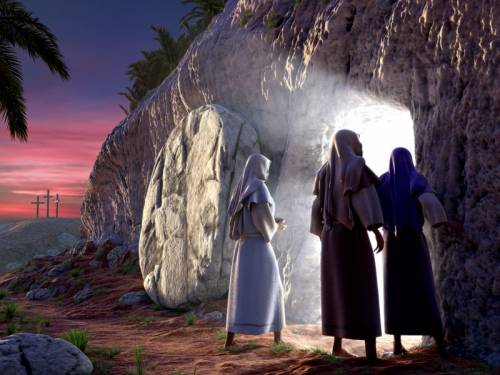It’s not about how the resurrection happened, but that it happened
By Barry Ensign-George | Presbyterians Today
 Amid the Easter celebrations, there are often questions about the resurrection. If we look closer, these resurrection questions begin even before we get to the Easter story. For example, in the transfiguration narrative, Jesus tells the three disciples who witnessed that event “to tell no one about what they had seen, until after the Son of Man had risen from the dead. So they kept the matter to themselves, questioning what this rising from the dead could mean” (Mark 9:9b–10). Indeed.
Amid the Easter celebrations, there are often questions about the resurrection. If we look closer, these resurrection questions begin even before we get to the Easter story. For example, in the transfiguration narrative, Jesus tells the three disciples who witnessed that event “to tell no one about what they had seen, until after the Son of Man had risen from the dead. So they kept the matter to themselves, questioning what this rising from the dead could mean” (Mark 9:9b–10). Indeed.
Scripture is blunt about it: The resurrected Jesus has a body that is recognizably made of human flesh. Thomas, one of Jesus’ disciples — sometimes known as “Doubting Thomas,” though perhaps it would be more accurate to call him “Questioning Thomas” — is insistent on this point: “Unless I see the mark of the nails in his hands, and put my finger in the mark of the nails and my hand in his side, I will not believe” (John 20:25b). A week later, Thomas encounters Jesus, whose body bears those very wounds that Thomas could indeed touch with his finger or hand, if need be.
Two questions arise persistently, though, for us: “How does this resurrection happen?” and “What chemical or other processes would make it happen?” These are questions of modern science. The power of asking and answering such questions is the stuff of our daily lives, vividly so in the development and discussion of COVID-19 vaccines. The problem for us is that Scripture is not interested in the “how” question. It is clear that the resurrection event is amazing (Luke 24:12) and perplexing (Luke 24:4). But the moment of resurrection itself happens offstage.
Scripture is, however, very interested in a different question: “Who?” Who is this, coming back to us, crossing the line between life and death so completely unexpectedly? In a moment of heart-stopping tenderness, Mary Magdalene goes to the place where she expects to find Jesus’ body and finds it is not there: “She turned around and saw Jesus standing there, but she did not know that it was Jesus” (John 20:14).
Easter, with all its questions about the resurrection, is about who Jesus is — and it is also about us and about our loved ones. One of the gifts I received while pastoring congregations was the opportunity to lead worship in funeral services. At funerals, we stand at the boundary between life and death with a directness most of us do not experience otherwise. At funerals, we stand at that boundary, looking across at death, marking the passage of one across the boundary, going on before us. Here, resurrection is no theoretical matter.
What I found there was how little I could say to answer the “how” question – a question I think I often felt more acutely than those for whom I was caring. Gradually I realized that the question I could speak to is “Who?” Because of Easter, we know something about who it is that we face across that boundary, who receives this one whom we accompany to the boundary, who will eventually receive you and me when our time has come to cross over.
The one whom we see, when we look with the eyes of Easter, is Jesus Christ, the one who has gone before us — and a familiar face. It is a face whose shape and contours we have been coming to know as we are part of the Body of Christ, the church. It is the face of one whom we have praised, sung to and of whom we have studied, wrestled with, worshipped, doubted, believed, wondered about, failed, ignored and sought out. It is a face that looks like those who have loved us in ways that have embodied God’s love and grace, a face that looks like those beyond the ones we know, beloved by Jesus Christ and therein part of Christ’s love for us.
The question of how the resurrection occurred is valid and important. Answers to the question are being proposed, examined and countered constantly. Books on this question and the answers are steady sellers for publishers. But it is not the only question. The better question to ponder is not how Jesus was resurrected, but who this Resurrected One is for us. Who is it that we face at this boundary of life and death? Easter is the affirmation that it is Jesus Christ, the one who has gone before and is present now.
Barry Ensign-George is a teaching elder in the Presbyterian Church (U.S.A.), serving as coordinator of Theology & Worship in the Presbyterian Mission Agency and staff liaison to the Committee on Theological Education.
Support Presbyterian Today’s publishing ministry. Click to give
![]() You may freely reuse and distribute this article in its entirety for non-commercial purposes in any medium. Please include author attribution, photography credits, and a link to the original article. This work is licensed under a Creative Commons Attribution-NonCommercial-NoDeratives 4.0 International License.
You may freely reuse and distribute this article in its entirety for non-commercial purposes in any medium. Please include author attribution, photography credits, and a link to the original article. This work is licensed under a Creative Commons Attribution-NonCommercial-NoDeratives 4.0 International License.